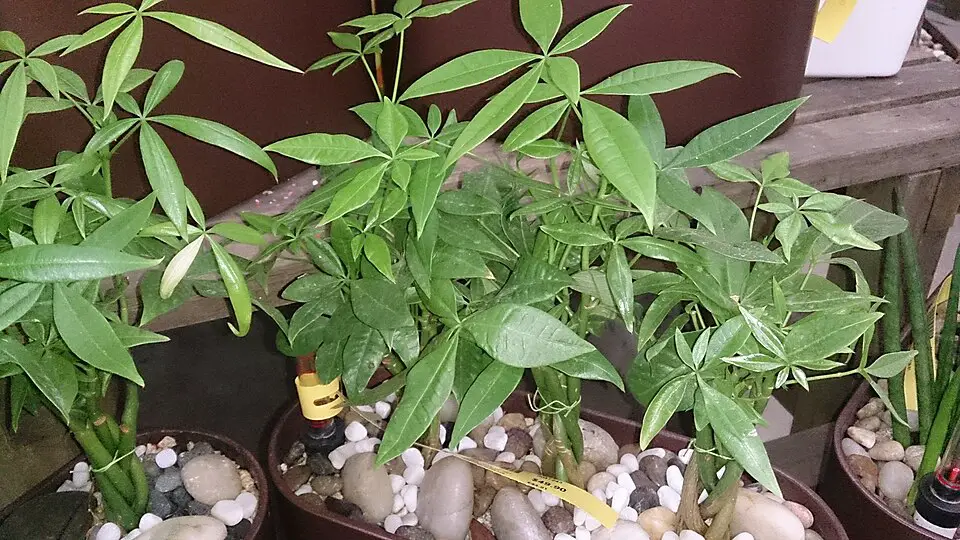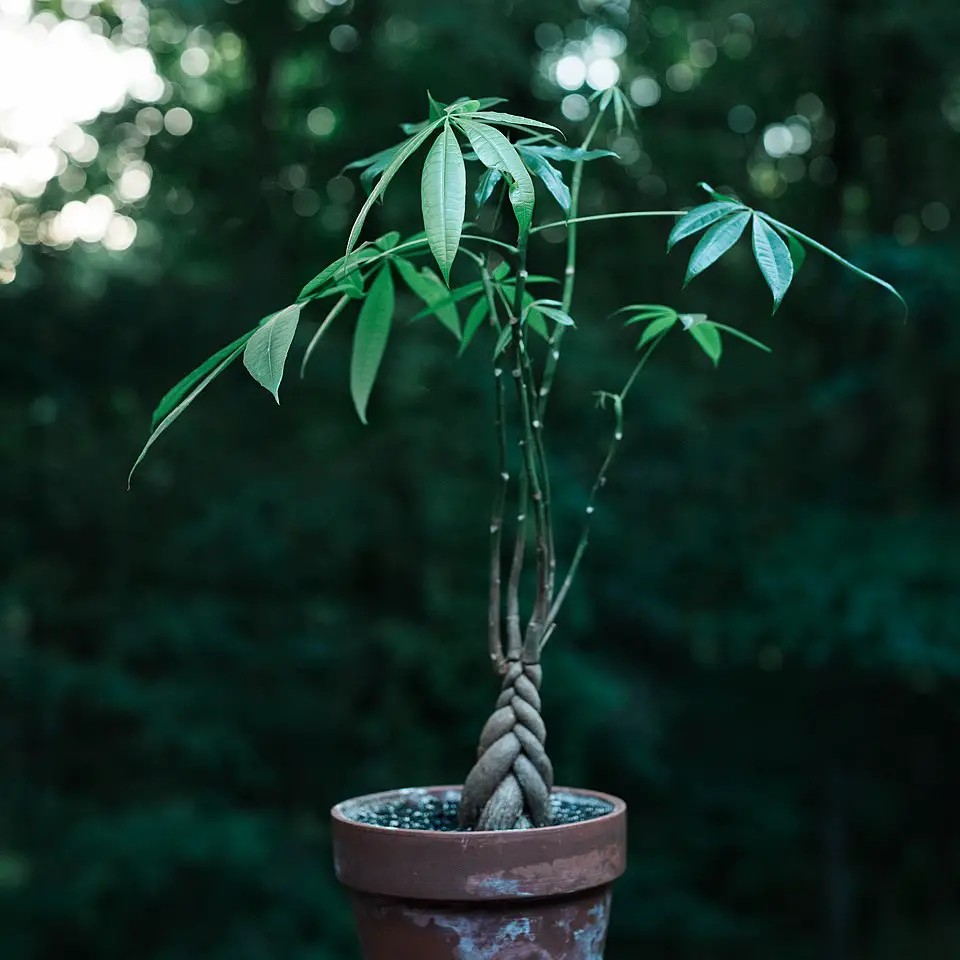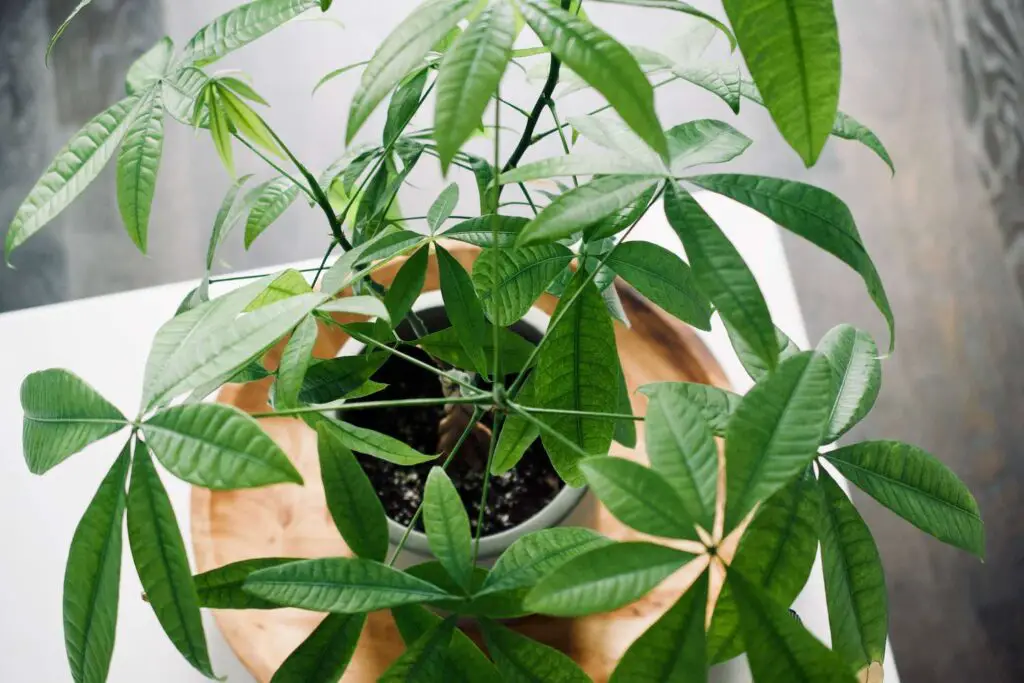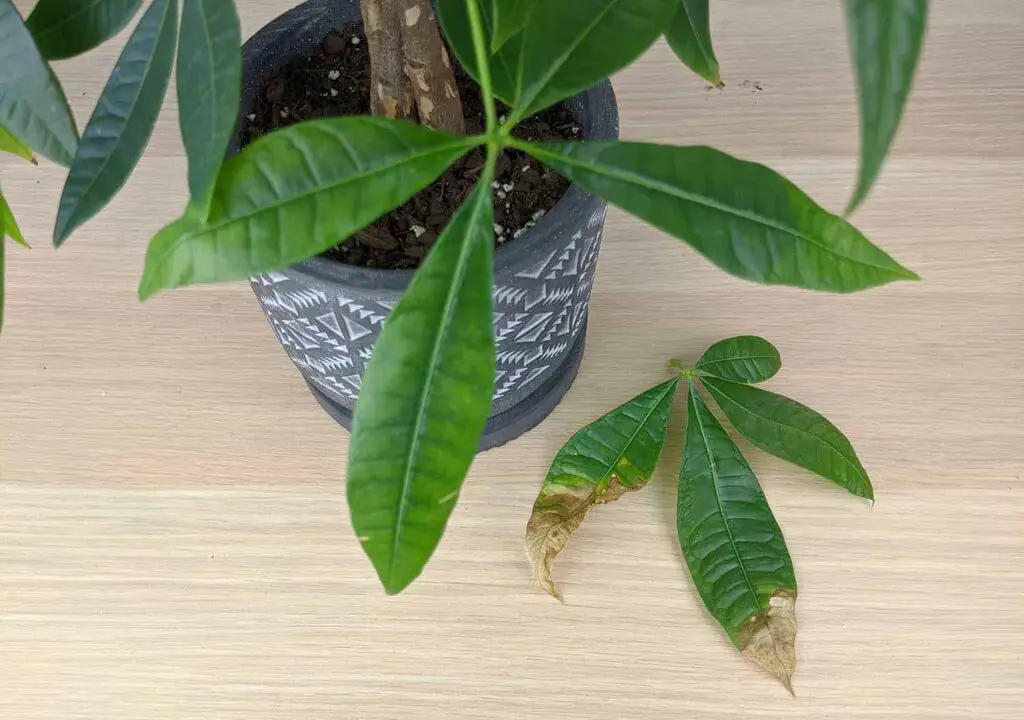Money Tree plants drop leaves due to a variety of factors, including overwatering, underwatering, inadequate light, pests, or sudden temperature changes. Identifying the cause is crucial for restoring the plant’s health. Adjusting care practices can help revive your Money Tree and prevent further leaf loss.
Understanding the Money Tree
The Money Tree, scientifically known as Pachira aquatica, is a popular houseplant known for its attractive braided trunk and lush green leaves. This tropical plant is not only aesthetically pleasing but is also associated with good fortune and prosperity in many cultures. Native to Central and South America, the Money Tree thrives in humid environments and requires specific care to flourish indoors.

Despite its hardiness, the Money Tree can experience issues that lead to leaf drop. Understanding the common causes behind this phenomenon is essential for any plant owner. Leaf drop can be alarming, especially when it occurs suddenly. It often indicates that the plant is stressed and needs immediate attention.
Common Causes of Leaf Drop
There are several reasons why a Money Tree may drop its leaves. Here are the most common causes:
- Overwatering: Excess moisture can lead to root rot, which prevents the plant from absorbing essential nutrients.
- Underwatering: On the opposite end, insufficient water can cause stress, leading to leaf drop.
- Inadequate Light: Money Trees prefer bright, indirect light. Too little light can weaken the plant.
- Pests: Insects like spider mites or aphids can damage the plant, resulting in leaf loss.
- Temperature Changes: Sudden fluctuations in temperature can shock the plant and lead to dropping leaves.
Identifying Overwatering Issues
Overwatering is one of the most common causes of leaf drop in Money Trees. When a plant receives too much water, it can cause root rot, a condition where the roots decay due to lack of oxygen. Signs of overwatering include:

- Yellowing leaves
- Wilting despite wet soil
- Mushy or brown roots
If you suspect overwatering, it’s important to act quickly. Allow the soil to dry out completely before watering again. Additionally, consider repotting the Money Tree in fresh, well-draining soil to promote healthy root growth.
Recognizing Underwatering Symptoms
On the other hand, underwatering can also lead to leaf drop. When a Money Tree does not receive enough water, it will prioritize survival over growth. Symptoms of underwatering include:
- Crispy or dry leaf edges
- Leaves curling inward
- Drooping leaves
To remedy underwatering issues, gradually increase your watering schedule. Ensure that the top inch of soil dries out before watering again. It is crucial to find a balance to keep your Money Tree healthy.

Light Requirements
Light plays a significant role in the health of a Money Tree. While these plants adapt to various light conditions, they thrive best in bright, indirect light. Insufficient light can lead to weak growth and subsequent leaf drop. Here are some tips for ensuring adequate lighting:
- Avoid placing the Money Tree in direct sunlight, as this can scorch its leaves.
- Consider rotating the plant regularly to ensure all sides receive light.
- If natural light is limited, supplement with grow lights during darker months.
Pest Management
Pests can also contribute to leaf drop in Money Trees. Regularly inspect your plant for signs of infestation. Common pests include spider mites and aphids. These pests suck sap from the leaves, weakening the plant. To manage pests effectively:
- Use insecticidal soap or neem oil as a natural treatment.
- Isolate affected plants to prevent spread.
- Regularly clean leaves to deter infestations.
Addressing pest problems promptly will help protect your Money Tree from further damage and promote healthy growth.
Watering Techniques for Healthy Growth
Proper watering is essential for the health of your Money Tree. Both overwatering and underwatering can lead to leaf drop, so finding the right balance is key. Understanding the plant’s watering needs based on its environment will help maintain its vitality.

Determining the Right Watering Schedule
The watering needs of a Money Tree can vary based on factors such as season, humidity, and pot size. Here are some guidelines to consider:
- Check the Soil Moisture: Before watering, stick your finger about an inch into the soil. If it feels dry, it’s time to water.
- Seasonal Changes: During the growing season (spring and summer), Money Trees typically require more water. In fall and winter, reduce watering as the plant enters dormancy.
- Watering Method: Water thoroughly until it drains from the bottom of the pot. This ensures that moisture reaches the entire root system.
Signs of Improper Watering
Being aware of the signs of improper watering can help you take action before serious damage occurs. Keep an eye out for these indications:
- Yellow Leaves: This may signal both overwatering and underwatering; check soil moisture to determine the cause.
- Leaf Dropping: Sudden leaf drop may indicate that the plant is either too dry or too wet.
- Mold or Fungus: If mold appears on the soil surface, you may be overwatering.
Temperature and Humidity Considerations
The Money Tree thrives in warm, humid environments. Keeping your plant in suitable temperature and humidity conditions will help reduce stress and prevent leaf drop.
Ideal Temperature Range
The ideal temperature range for a Money Tree is between 65°F to 80°F (18°C to 27°C). Here are some tips to maintain suitable temperatures:
- Avoid Drafts: Keep your plant away from cold drafts from windows or doors, as sudden temperature changes can shock it.
- Heat Sources: Position your Money Tree away from heating vents or radiators that can create hot air blasts.
Humidity Levels
Money Trees enjoy humidity levels of around 40% to 60%. If your home is particularly dry, especially during winter, consider these methods to increase humidity:
- Misting: Lightly mist the leaves with water several times a week to increase humidity around the plant.
- Humidifiers: Use a humidifier in the room where the Money Tree is located to maintain consistent humidity levels.
- Pebble Tray: Place a tray filled with water and pebbles under the pot. As the water evaporates, it will create humidity around the plant.
Soil and Pot Selection
The right soil and potting choice can significantly impact your Money Tree’s health. Poor soil drainage or inadequate pot size can lead to various issues, including leaf drop.
Choosing the Right Soil
A well-draining potting mix is crucial for a healthy Money Tree. Consider these options:
- Cactus Mix: A cactus or succulent mix provides excellent drainage for Money Trees.
- Custom Mix: You can create your own mix using equal parts potting soil, perlite, and sand to ensure good drainage.
Selecting an Appropriate Pot
The pot you choose for your Money Tree should have proper drainage holes. Here are some factors to consider:
- Size: Choose a pot that is slightly larger than the current one to allow for growth, but avoid oversized pots as they can retain too much moisture.
- Material: Terracotta pots are great for promoting airflow and moisture control, while plastic pots can retain more moisture.
Repotting Your Money Tree
If you notice that your Money Tree is becoming root-bound or has not been repotted in a long time, it may be time to consider repotting. Repotting can rejuvenate your plant and promote healthier growth.
Whe
n repotting, follow these steps:
- Choose a New Pot: Select a pot that is one size larger with good drainage.
- Prepare the New Soil: Use fresh potting mix suitable for Money Trees.
- Gently Remove the Plant: Carefully take the plant out of its current pot without damaging the roots.
- Trim Dead Roots: If you notice any mushy or dead roots, trim them off before placing the plant in its new pot.
- Add Soil and Water: Fill around the roots with soil and water thoroughly after repotting.
By following these guidelines, you will help create a stable environment for your Money Tree, reducing the chances of leaf drop and improving its overall health.
Fertilization for Optimal Growth
Fertilization is a crucial aspect of caring for your Money Tree, as it provides essential nutrients that promote healthy growth and vitality. A well-fertilized plant is less likely to experience stress, which can lead to leaf drop.
Understanding Nutrient Needs
Money Trees require a balanced supply of nutrients to thrive. The primary nutrients include nitrogen, phosphorus, and potassium, often referred to as N-P-K. Each of these plays a unique role in plant health:
- Nitrogen: Promotes healthy leaf and stem growth.
- Phosphorus: Supports root development and flowering.
- Potassium: Enhances overall plant health and disease resistance.
Choosing the Right Fertilizer
When selecting a fertilizer for your Money Tree, consider the following options:
- Liquid Fertilizers: These are easy to apply and can be mixed with water. They provide quick nutrient uptake.
- Slow-Release Fertilizers: These fertilizers gradually release nutrients over time, reducing the need for frequent applications.
- Organic Options: Organic fertilizers such as fish emulsion or worm castings can provide gentle nourishment without chemical additives.
Fertilizing Schedule
Establishing a fertilizing schedule is vital for maintaining your Money Tree’s health. Here are recommended practices:
- Growing Season: Fertilize every four to six weeks during the spring and summer months when the plant is actively growing.
- Dormant Period: Reduce or eliminate fertilization in the fall and winter when growth slows down.
- Watering After Fertilizing: Always water your Money Tree after applying fertilizer to help distribute nutrients evenly throughout the soil.
Environmental Stress Factors
Environmental factors can also significantly affect your Money Tree’s health. Stress from inadequate conditions can lead to leaf drop. Here are some common environmental stressors to consider:
Air Quality
Poor air quality can impact plant health. Money Trees thrive in clean, fresh air. Here are ways to improve air quality around your plant:
- Avoid Smoking: Keep smoking away from indoor plants, as tobacco smoke can harm their health.
- Use Air Purifiers: Consider using air purifiers to reduce pollutants and improve air circulation.
- Ventilation: Ensure rooms are well-ventilated to prevent stagnant air that can harbor pests and mold.
Seasonal Changes
Seasonal changes can also affect your Money Tree’s well-being. As temperatures fluctuate, so do the needs of the plant:
- Winter Care: During colder months, ensure your plant is kept in a warm location away from drafts.
- Summer Heat: In extreme summer heat, monitor soil moisture closely, as higher temperatures can dry out the soil quickly.
Common Myths About Money Trees
There
are many myths surrounding the care of Money Trees that can lead to misconceptions about their needs. Here are a few common myths debunked:
Myth: Money Trees Don’t Need Watering in Winter
This myth can lead to underwatering during the winter months. While growth slows, Money Trees still require some water but at reduced levels. Always check the soil moisture before watering.
Myth: Money Trees Are Unkillable
While Money Trees are known for being hardy, they are not invincible. Neglecting their basic needs such as proper watering, lighting, and nutrients can lead to serious health issues.
Myth: All Houseplants Thrive on the Same Care
This misconception can be detrimental. Each plant has unique requirements based on its native habitat. Understanding the specific needs of your Money Tree will help ensure its success.
Monitoring Your Plant’s Health
<pRegular monitoring of your Money Tree’s condition can help catch potential problems early. Here are some tips for keeping an eye on your plant's health:
Routine Inspections
Make it a habit to inspect your Money Tree regularly. Look for:
- Color Changes: Yellowing or browning leaves may indicate poor care conditions.
- Pest Presence: Check for any signs of pests on leaves and stems.
- Mold or Fungal Growth: Look for any signs of mold on the soil or leaves.
Keeps Records
Keeping a care journal can help track watering, fertilization, and any changes in your plant’s condition. This provides valuable insight into what works best for your Money Tree.
If you notice persistent issues despite following care guidelines, consulting a local plant expert or extension service may provide further assistance and solutions.
Additional Tips for Maintaining a Healthy Money Tree
In addition to
the essential care practices discussed, there are several other tips you can implement to ensure your Money Tree remains healthy and vibrant. These practices can help prevent common issues that lead to leaf drop.
Seasonal Adjustments
As mentioned previously, seasonal changes can significantly impact your Money Tree’s health. Here are some additional adjustments to consider throughout the year:
- Summer Care: During the hotter months, increase humidity levels around your plant. This can be done by grouping plants together or using a humidifier.
- Winter Light Adjustment: As daylight decreases, consider moving your Money Tree closer to a window to ensure it receives adequate light.
Proper Pruning Techniques
Pruning can help maintain the shape of your Money Tree and promote healthier growth. Here are some guidelines for effective pruning:
- Timing: Prune during the growing season (spring and summer) when the plant is actively growing.
- Remove Dead or Yellowing Leaves: This helps the plant focus its energy on healthier leaves.
- Cut Above a Node: When trimming branches, make cuts just above a leaf node to encourage new growth.
Creating an Ideal Environment
The environment in which your Money Tree is placed can play a crucial role in its overall health. Consider these aspects:
- Placement: Choose a location that offers bright, indirect light and maintains stable temperatures.
- Avoid Overcrowding: Ensure your Money Tree has enough space to breathe and grow without competition from other plants.
Final Thoughts
Caring for a Money Tree requires attention to detail and an understanding of its specific needs. By following the guidelines outlined in this article, you can ensure that your plant remains healthy and vibrant. Key factors include proper watering techniques, adequate lighting, suitable soil and pot selection, and regular monitoring for pests and diseases. Additionally, remember that environmental factors such as humidity and temperature play significant roles in the plant’s overall health.
Regular inspections and record-keeping will help you identify any potential issues early on, allowing you to take corrective measures before serious damage occurs. If problems persist despite your best efforts, seeking advice from local gardening experts or plant care resources can provide valuable insights.
The Money Tree is not only a beautiful addition to your home but also a symbol of prosperity and good fortune. By investing time and care into your plant, you will create an environment where it can thrive for years to come. Enjoy the journey of nurturing your Money Tree, and take pride in watching it flourish!
